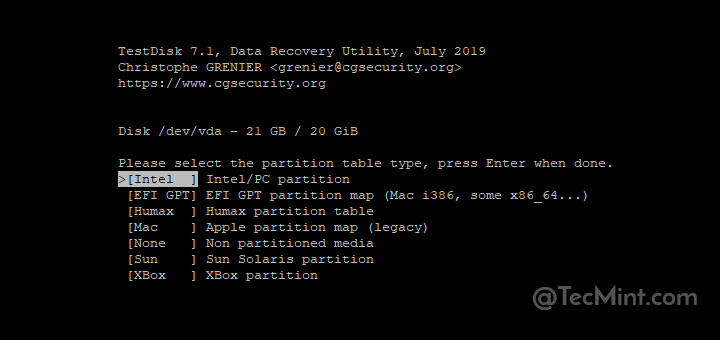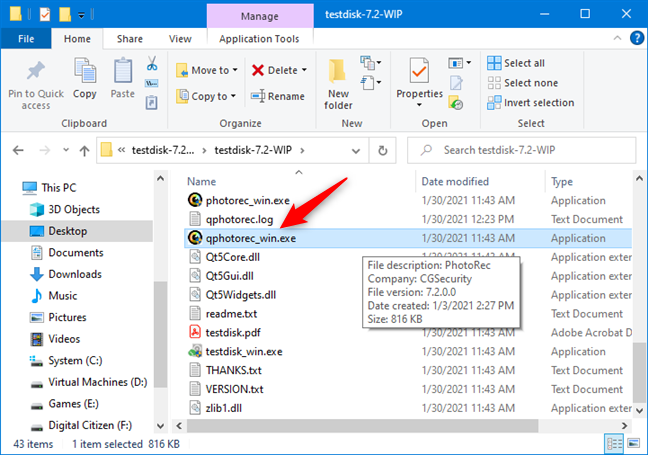
- Gui for testdisk how to#
- Gui for testdisk software#
- Gui for testdisk professional#
- Gui for testdisk free#
If your device is damaged, it is advisable to image the device and work on the image file for data recovery.
Gui for testdisk professional#
If your data is not replaceable, do not attempt to write to the failed device if the following applications do not work but seek professional advice instead.
Gui for testdisk software#
The following software will passively try to recover your data from failed or failing hardware. Be certain that the "live" cd does not automatically mount any partition or swap space. Shut down the affected machine as soon as possible, and restart it from a LiveCD or LiveUSB. You should NOT write to the failed device, as it can worsen a hardware failure, and overwrite existant data in case of lost files. The data is recoverable because the information is not immediately removed from the disk. Extract individual files from recovered imageĭeleted or lost files can sometimes be recovered from failed or formatted drives and partitions, CD-ROMs and memory cards using the free/libre software available in the Ubuntu repositories.Extract filesystem from recovered image.Ran out of space while imaging the drive?.Imaging a damaged device, filesystem or drive.Join the nixCraft community via RSS Feed, Email Newsletter or follow on Twitter. He wrote more than 7k+ posts and helped numerous readers to master IT topics. Vivek Gite is the founder of nixCraft, the oldest running blog about Linux and open source.
Gui for testdisk how to#
See How To Linux Check IDE / SATA Hard Disk Transfer Speed and man pages: hdparm(1) for more information. For detailed I/O performance benchmarking try the "The Flexible I/O Tester (FIO)" for Unix or Linux. You learned how to use the dd under Linux or Unix for testing simple and sequential I/O performance measurement. The benchmark generates and measures a variety of file operations.

If you are using GNU/Linux use the dd command ( dd if=/dev/zero of=/tmp/testALT.img bs=1G count=1 conv=fdatasync).I recommend dd command on all Unix-like systems ( time sh -c "dd if=/dev/zero of=/tmp/testfile bs=100k count=1k & sync".Test the performance of your hard disk using ‘Disks’ Which method and command do you recommend to use to test disk I/O performance? In this example, 512 bytes were written one thousand times to get RAID10 server latency time: This option is equivalent to oflag=dsync. conv=fdatasyn: Again, this tells dd to require a complete “sync” once, right before it exits.This option get rid of caching and gives you good and accurate results oflag=dsync ( oflag=dsync) : Use synchronized I/O for data.count=1 ( count=number-of-blocks): The number of blocks you want dd to read.If your test system does not have sufficient RAM available, use a smaller parameter for bs (such as 128MB or 64MB and so on).
Gui for testdisk free#
Please note that Linux will need 1GB of free space in RAM.

Please note that one gigabyte was written for the test and 135 MB/s was server throughput for this test. The basic syntax is as follows to find out server throughput:įig.01: Ubuntu Linux Server with RAID10 and testing server throughput with dd In this example, I’m using RAID-10 (Adaptec 5405Z with SAS SSD) array running on a Ubuntu Linux 14.04 LTS server. The dd command is useful to find out simple sequential I/O performance. We can also use the dd command to measure server latency:ĭd if=/dev/zero of=/tmp/test2.img bs=512 count=1000 oflag=dsync.Use the dd command to measure server throughput (write speed):ĭd if=/dev/zero of=/tmp/test1.img bs=1G count=1 oflag=dsync.Use dd command to monitor the reading and writing performance of a disk device: The nixCraft or author is not responsible for any data loss. Wrong SSD or hard disk drive device names can wipe out your data. Ĭaution: Be careful with device names when using the dd command. In this tutorial you will learn how to use the dd command to test disk I/O performance.

hdparm command : It is used to get/set hard disk parameters including test the reading and caching performance of a disk device on a Linux based system.dd command : It is used to monitor the writing performance of a disk device on a Linux and Unix-like system.


 0 kommentar(er)
0 kommentar(er)
